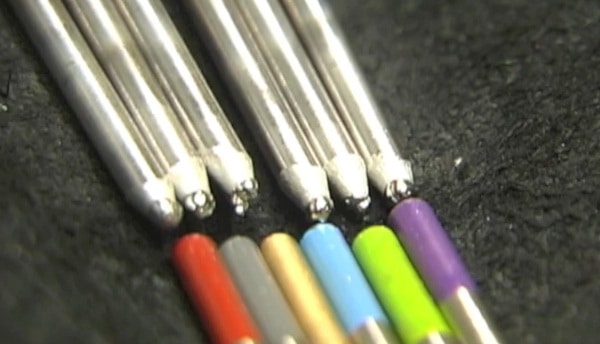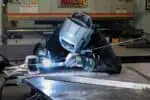TIG welding aluminum is quite common in the welding arena. And choosing the right tungsten is something that often raises questions. Well worry not, for today I am going to answer all your queries!
Tungsten electrodes are seen as a requisite for TIG welding. Choosing the best among the electrodes for aluminum welding can be done once you are aware of the properties and learn how well they can serve your welding purpose. But for that, a thorough study of each electrode is necessary.
Continue reading to know more…
Why is tungsten better than other metals to weld aluminum?
Tungsten, unlike other metals, has a high melting point. In TIG welding especially, the electrodes used need to be non-consumable and tungsten is perfect for serving this purpose because of the said quality.
Moreover, as aluminum is a tricky metal to weld, it demands good heat control and high temperature to melt which can be ensured only with tungsten electrodes.
What are all the factors to be considered while selecting a tungsten rod to weld aluminum?
TIG welding requires you to decide the type of tungsten before deciding anything else. A few factors that you need to focus on are:
1.) AC/DC inverter: AC refers to alternating current and DC stands for Direct Current. The welder that you choose can be of either type. Alternating Current can change the flow of current with time but with Direct Current the flow stays the same.
Tungsten rods depending on the constituents can vary in their heat resistance. With AC, the issue would not be a problem, but with DC some tungsten rods tend to get burned up.
2.) Type of metal/alloy: Generally, the tungsten is decided also based on the type of metal used. Here the base metal is Aluminium and therefore all you have to is to find the right tungsten rod that goes with the properties of aluminum. I will talk about the same in the coming sessions.
3.) Type of weld: Tungsten rods are also decided based on the type of weld. After learning the requirements and understanding the type of weld needed, the rods can be chosen that suit the same.
See also: MIG Vs TIG Welding Aluminium
What are the advantages of choosing the right tungsten for welding aluminum?
Choosing the right tungsten rod has advantages as follows:
1.) To maximize benefits: Using the right tungsten for the chosen inverter can ensure that the rod is used up to the maximum. As each tungsten electrode differs in terms of the materials included, the effect may slightly vary.
Decide the settings of the inverter and choose the tungsten that goes with the configuration to get the maximum benefit.
2.) To get quality weld: Tungsten whether pure or not can ensure you good quality weld based on its properties that go with the type of current used. The right tungsten can assure a smooth weld if used properly.
3.) To avoid post-clean-up mess: In some cases, the wrong tungsten can leave a mess behind the welding procedure giving you trouble.
Various types of tungsten choices available for welding aluminum?
Tungsten rods come in different sizes and colors. Let’s see the tungsten electrodes mostly used for welding aluminum:
1.) Pure tungsten: These electrodes are pure and come in green color. Being 100% tungsten they are highly preferred for the arc stability and balling up feature when heated.
They are also known for the clean weld that they are capable of. In addition to these qualities, these are also dirt cheap. However, pure tungsten electrodes can only be used in DC for welding aluminum.
2.) 2% ceriated: Seen in the grey coloured label, these electrodes consist of 2% cerium. Usually, these electrodes are used for aluminum in lower amperage DC welders.
2% ceriated electrodes are known for their durability. They can be used in AC welders as well. Most difficult welding applications prefer these electrodes.
3.) 2% lanthanated: 2% lanthanated electrodes can handle amperage better than other electrodes. They are coded in blue and are extremely useful in welding alloys, especially aluminum.
2% lanthanated electrodes are found suitable for thinner aluminum sheets (1/8) in AC as the amperage used is less.
4.) 1.5% lanthanated: Labeled in gold color, these electrodes are also used for welding aluminum. However, when compared to 2% lanthanated, their preference falls slightly below 2% lanthanated.
This is because the 2% lanthanated handles heat better than 1.5% lanthanated electrodes.
5.) 2% thoriated: These are the least preferred electrodes for welding aluminum. They are allotted red for identification. 2% thoriated is said to be radioactive even though there are varying opinions about the same.
The American Welding Society in 2003 has come up with certain recommendations to reduce the exposure from rays that are released while using these electrodes.
Check this link to know more about it: http://files.aws.org/technical/facts/FACT-27.pdf. Moreover, the tungsten electrodes are also said to create irregularities while welding making it less favorable.
6.) 0.8% Zirconiated: These white-color coded electrodes are widely used for aluminum welding in AC applications. Known for their less heat resistance capability, these electrodes can be easily balled up to make them suitable for welding. However, these have a shorter lifespan and lower current capacity when compared to other electrodes.
7.) Rare Earth Mix: Seen as a substitute for thoriated tungstens, these purple electrodes are highly preferred for their good properties. Since the former is said to be harmful, these tungsten electrodes are becoming popular by the day.
To get a quick idea of the electrodes in general do refer the table given below:
| Tungsten | AWS classification | Colour Designation | Principal Oxide | Characteristics | Applications |
|---|---|---|---|---|---|
| Pure | EWP | Green | None | Balls fast, Spits at higher current, Non-critical tasks | Alternating Current (A/C), Aluminum/ Magnesium Alloys, Low to Medium Amps |
| 2% Ceriated | EWCe-2 | Grey | Cerium Oxide (1.8–2.2%) | Good Ignition or Re-Ignition, Good Arc Stability, Low Erosion, Low Amp Range, No Spitting, Extended Service Life | A/C and D/C, Low-Alloy, Non-Corroding Aluminum, Copper, Magnesium, Nickel, Steel, and Titanium Alloys |
| 2% Lanthanated | EWLa-2 | Blue | Lanthanum Oxide (1.8 – 2.2%) | Good Arc Starts with Stability, Low Erosion, Medium to High Amp Range | A/C and D/C, Low-Alloy, Non-Corroding Aluminum, Copper, Magnesium, Nickel, Steel, and Titanium Alloys |
| 1.5% Lanthanated | EWLa-1.5 | Gold | Lanthanum Oxide (1.3 –1.7%) | Excellent Arc Start, Great Arc Stability, Low Erosion Rate, No Spitting | Direct Current (D/C), Non-corroding copper, nickel, steel, and titanium alloys, Wide Amp Range |
| 2% Thoriated | EWTh-2 | Red | Thorium Oxide (1.7–2.2%) | Good Arc Start, Arc Stability, Moderate Erosion Rate, Spits Moderately | Direct Current (D/C), Non-corroding copper, nickel, steel, and titanium alloys, Only Medium Amp Range |
| 0.8% Zirconiated | EWZr-1 | White | Zirconium Oxide (0.7– 0.9%) | Good Arc Starts with Stability, Low Erosion, High Amp Range, Spits a Little | A/C, Aluminum and Magnesium Alloys |
| Rare Earth (LayZr) | EWG | Purple | Lanthanum (1.5%), Zirconium (0.08%), Yttrium Oxides (0.08%) | Best Arc Starts at Low Amperage, Stable Tip, Low to Medium Amp Range, Extended Service Life | A/C and D/C, Robotic Applications, Low-Alloy, Non-Corroding Aluminum, Copper, Magnesium, Nickel, Steel, and Titanium Alloys |
You might have a difficult time choosing the best tungsten among these. Truth be told, the tungsten you choose does not matter as much as you think. That said, you can’t ignore the minor differences among the welds while using these tungstens.
However, the ultimate focus should be on the configuration of your welder. Irrespective of the tungsten chosen, always make sure to keep the welder set right for the selected tungsten. This will help to keep the procedure smooth.
How did new alloyed tungsten electrodes become popular?
New alloyed tungsten electrodes like most of the ones that we have mentioned above are also known as hard tungsten. Unlike soft tungstens, (pure or ceriated) hard tungstens or new alloyed tungsten electrodes are suitable for inverters that can alternate the flow of current between positive and negative.
They are powerful enough to stay the same without breaking when the change in the current flow happens. Soft tungstens were crafted to suit transformers that have a steady current flow.
New alloyed tungsten and tri-mix tungstens have become popular as they are compatible with modern inverters. With modern inverters, tungstens need not be balled up for ease in welding.
How to ball a tungsten rod for aluminum welding?
As I have mentioned in the above section, balling electrodes have become obsolete with new inverters. That said, with soft tungsten (pure) you will have to use the balling technique to get good aesthetic welds in aluminum.
Balled tungsten is known to give better arc strike as the ends of the electrodes are smoother when it is done.
Given below are the steps to ball a tungsten electrode:
Step 1: Sharpen one edge of the tungsten electrode to give a sharp edge
Step2: Place it aside to let it cool down for almost 10 minutes
Step 3: Repeat the same with the other side.
Step 4: Place the electrode in a TIG torch
Step 5: Make sure the TIG welder is placed on a conductive and stable surface and keep a piece of aluminum on top of it.
Step 6: Bring the tip of the TIG torch near to the aluminum and run the welder for a minimum of two minutes to observe a ball created at the tip of the electrode one-third its diameter size.
Step 7: Let the electrode cool and start welding the aluminum now with the new balled tip electrode and observe the perfection in the weld!
To Wrap Up
Tungsten is something that TIG welding can’t do without. When it comes to aluminum they become even more important. A mere blog is not enough to make you an expert in choosing the best electrode for the aluminum welding you are rooting for.
However, starting from basics and gradually moving to the practical side can help you grow as an expert TIG welder of aluminum!
See you in yet another enlightening blog! Till then bye…







